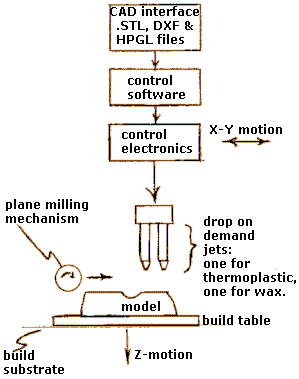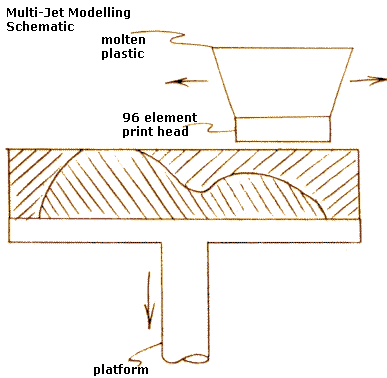Ink Jet Printing Techniques
Ink jet printing comes from the printer and plotter industry where the technique involves shooting tiny droplets of ink on paper to produce graphic images. RP ink jet techniques utilize ink jet technology to shoot droplets of liquid-to-solid compound and form a layer of an RP model. Common ink jet printing techniques, such as Sanders ModelMaker™, Multi-Jet Modeling™, Z402 Ink Jet System™, and Three-Dimensional Printing, are presented in this section. Although none of the these techniques have become as established as the Stereolithography (SLA) or Selective Laser Sintering (SLS®) systems, several show promise.
Sanders ModelMaker
•Exceptional accuracy allows use in the jewelry industry.
•Accuracy is partly enabled by a milling step after each layer deposition.
•Plotting system is a liquid-to-solid inkjet which dispenses both thermoplastic and wax materials.
•Compared to SLS® and SLA, not as established.
The Sander ModelMaker™ product is produced and distributed by Sanders Prototype, Inc. of Wilton, NH, USA. Smooth cosmetic surface quality can be achieved by pre-tracing the perimeter of a layer prior to filling in the interior. The supporting wax material is deposited at the same time as the thermoplastic. A schematic is shown below:

Both the thermoplastic material (Protobuild™) and the wax support material (Protosupport™) are proprietary materials of Sanders.
Multi-Jet Modeling
•Fast.
•Office-friendly: non-toxic materials, small footprint, low odor.
•Simple operation: operates as a network printer in an office environment.
•Models are primarily for appearance use.
•Compared to SLS® and SLA, not as established.
Another product of 3D Systems from the makers of the SLA system, Multi-Jet Modeling™ uses a 96-element print head to deposit molten plastic for layering. The system is fast compared to most other RP techniques, and produces good appearance models with minimal operator effort. The main market that this system is targeted at is the engineering office where the system must be non-toxic, quiet, small, and with minimal odor. The system is illustrated below:

Z402 Ink Jet System
•Fast: one to two vertical inches per hour, depending on layer density.
•Office-friendly: non-toxic materials, small footprint, low odor.
•Simple operation.
•Compared to SLA and SLS®, not as established.
The Z402™ is one of the fastest 3D printers known to Rapid Prototyping. The ability to produce quick models means greater productivity for the lab and quick prototypes for customers. Since manufacturing parts is easy, almost anyone in the lab can produce a quality part without extensive Rapid Prototyping experience.
Three-Dimensional Printing
•Binder is "printed" on unbound powder layer.
•Without milling step, work plane can become successively skewed.
•Not as established as SLA and SLS®.
Three-Dimensional Printing, developed by MIT and Soligen, Inc., is illustrated below. It is another technique based on the inkjet printing process. Binder is printed on a powder layer to selectively bind powder together for each layer


